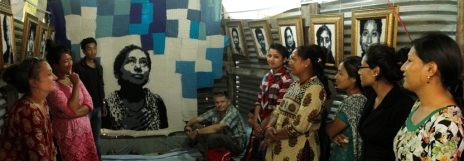Sheelasha Rajbhandhari in cooperation with Urmila Khaiju, Bina Koju, Kesari Suwal, Sapana Basukala, Juneli Basukala, Unita Kasula, Rabina Koju, Saru Basukala, Ani Khaiju, Rabita Thapa.
“Nuga Ya Kha Thyaagu”, 2015. Kindly lent by Dina Bangdel.
Many women of Thulo Byasi are skilled knitters, they work at home supplying a range of knitted wear to various exporters. Like many other women employed in the home-based worker industry.
After the earthquake the women were traumatized and many suffered from depression. By using their existing skill for a new purpose engaged them and helped them cope with the stress of managing a household in the problematic aftermath of the quake.
Their knitted portraits are presented inside ornate frames to emphasize the role women play in society as well in the economy well-being but not recognized by a very patriarchal Nepal.

Art is my language
My mother was an educator and my father a photography enthusiast. I don’t come from a family with an art background but art was always around me. My father with his photography and my mother who loved dancing. I started drawing when I was small. At a young age I realized that I could effectively communicate visually rather than verbally.
In school when the teacher asked us what we wanted to be when we grew up, my friends would always say typical things like doctor and engineer while I always said I want to be an artist. It was always easier for me to understand life through art and pictures. I still have all my drawings till today.
After I finished high school we had a discussion at home about if art can be a profession. When I told my family I wanted to study art they thought it was a whimsical choice. Most people, including my family think that art is limited to painting; but art is beyond that. I chose to study sculpture.
People expect young girls to daintily sit and paint a flower but
here I was working with heavy wood, iron and mud. My clothes were often filthy covered with mud. They couldn’t understand why I would choose such a genre of art. My family would often question me saying things like “What other people in society will think? Who will marry you?” etc.
In hindsight, I think my family mostly supported my decision to become an artist but were afraid of what society would say. I didn’t dress up like most girls. Comfort was more important than fashion to me. I couldn’t go and make art wearing high heels. I didn’t wear jewelry or gold or bother about housework. Everyone called me a weirdo. I didn’t make any money. My parents were worried about looking bad in front of people because of my attitude.
Outside of home, the challenge started when I started my Bachelor’s and Master’s degree. I was an only woman among 17 boys in my class. This was difficult for me to cope with. In Nepal there are very few female artists but when I needed to prove myself I showed everyone what I was capable of. And slowly my family was also convinced.
It was very difficult as the only girl in class when we studied human anatomy and had to make nude paintings. The guys in class were always excited to do nude paintings and I always felt very awkward. In class the nude model was always a female. The boys in class would often demand a female model. But even in the rare occasion that we had a male model I would be very uncomfortable when I had to look at their lower body and draw it. Even looking at an image on a book was difficult. Slowly I started making it easier for
myself and told myself that even doctors had to go through the same situation so its very normal.
The first body of art I created was about how Kathmandu had changed in such a short time. How have the changes affected people’s lives? What is change? Is there development just because there is an increase in population in a city?
I had not worked on women’s issues until then. In 2008, my subject for my art was abortion. But even this wasn’t from a female reproductive rights point of view. It was more like:
why do people abort? How is the fetus affected? Why is the ratio of abortion rising? What kind of physical pain does one go through?
My family never really discriminated between me and my brother. But there came a time when I felt discriminated against and it was when I had my first menstruation. I wasn’t allowed to enter the kitchen. They had a separate plate for me to eat from.
If I touched someone while on my period, they would have to take a bath. On top of that I couldn’t understand the physical changes and psychological effect I was going through. At those particular moments I regretted being born as a girl. I didn’t know how to handle the pain during my period. Slowly I understood and was able to handle the situation. Slowly changes were made in my house as well and today we have no such ‘untouchable’ system.
I didn’t earn any money for a long time after I finished my school. It was like being an outcast from society. Most people could not understand what we, art students, were doing. They thought we didn’t care about our future.
Art was not common profession like doctor and engineering. Until and unless people can’t feel what art is, they can’t describe it. So
I don’t blame society for its misconception of art.
Sheelasha R